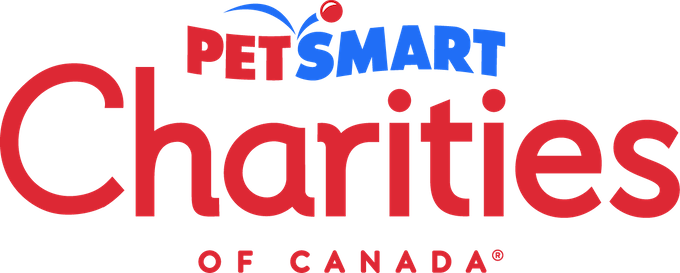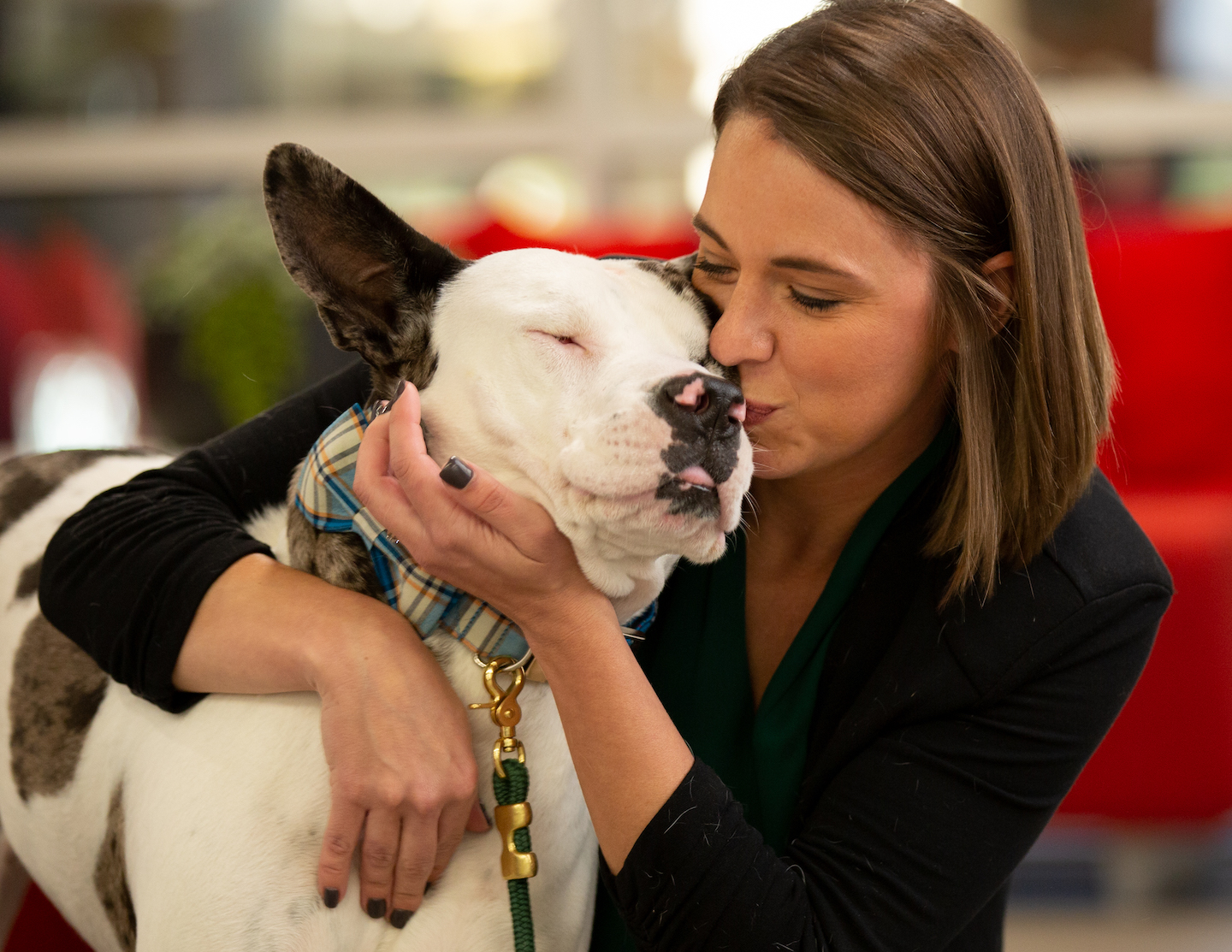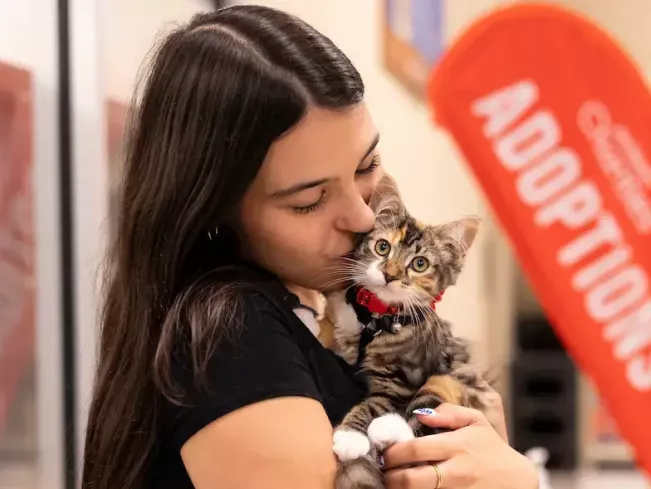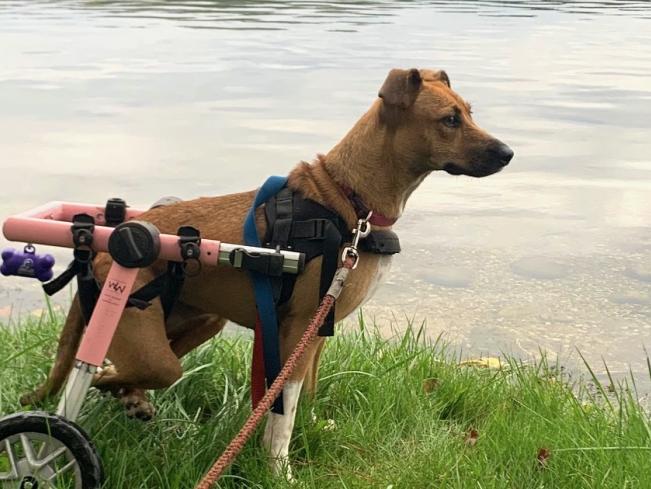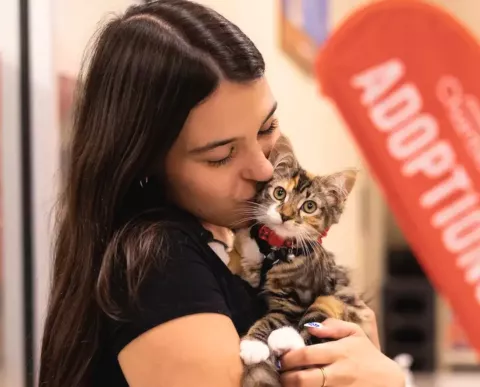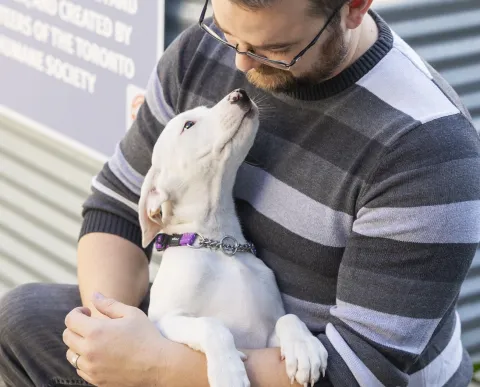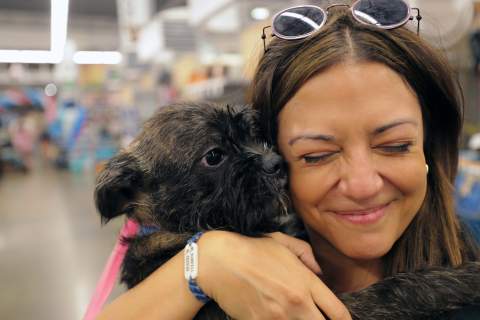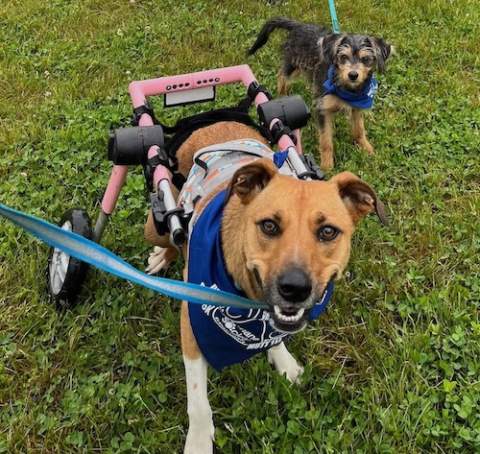Even in a room filled with irresistibly adorable puppies and dogs, pet adoption was the furthest thing from Heidi's mind.
As the Director of Pet Placement Initiatives for PetSmart Charities, it's not unusual for Heidi to find herself surrounded by adoptable pets. "Part of my role at PetSmart Charities is to work with rescue groups and organizations that operate shelters across the North America," explains Heidi. But then, while touring the Arizona Animal Welfare League shelter, she met Gatsby, a six-year-old special needs Great Dane.
“They pointed him out to me in his kennel, and he was sitting quietly, and I came to find out he was blind and deaf, and my heart went out to him.”
While Heidi (like many of us) would love to adopt every single pet in need, she knows that's not a feasible goal. That's why her first instinct was to share Gatsby’s story with a prospective adopter.
"I took a video of Gatsby in his kennel and sent it to a friend of mine who was looking for a pet and suggested that she come and meet him," recalls Heidi. "But, when I went home and showed the video to my partner, he said, 'what are you doing? You have to go get that dog. He's amazing."
She was not in the market for another dog – they had their hands full with their other dog Kemper – who had been through more than any living being should have to endure. They briefly entertained adopting another pet but Gatsby wasn’t exactly what they had in mind.
“What is so amazing about Gatsby is although he may be blind, I really feel like he can SEE you. He and Kemper connected almost immediately. Gatsby brings such a calming and loving energy everywhere he goes, it’s unbelievable how a dog that can’t see or hear can communicate with those around him like that,” says Heidi.
The rest is history.
Gatsby-Proofing
When she first brought Gatsby home, there was a lot of careful consideration about how to care for Gatsby and keep him safe.
"Like baby-proofing our house, we Gatsby-proofed our house," says Heidi.
Heidi’s partner got extra creative and shielded sharp corners with perfectly sized pool noodles to prevent head bumps. They also leaned in on Gatsby's strengths, like his sense of smell and touch, to help guide him. "We put scents by the door, so he knows that the smell of lavender, for example, leads him outside. We also use different flooring throughout the house so he can figure out which part of the house he's in."
Building Confidence
Gatsby quickly began the process of learning and maneuvering around his new surroundings. Of course, there were literal bumps along the way, but Heidi learned to trust Gatsby’s instincts. He taught her over the course a few short days that by staying out of his way she was giving him space to grow.
The first few days, Gatsby slowly wandered around the backyard. He would walk in tiny circles, and slowly the circles would get larger until soon enough, he started running across the yard, staying within bounds.
"That was the moment we knew he was truly comfortable and felt like he was home. That was really special for us because it showed us that he trusts us now to keep him safe and feels comfortable in his home, which is always the ultimate goal."
Heidi also noticed that it seemed Gatsby had no experience playing with toys. They researched options and got him some very specific toys recommended for blind and/or deaf dogs. “He had no interest,” laughs Heidi. “However, he does love chewing Crocs. My husband is a die-hard fan of Crocs, so it’s fun to see.”
Lessons Learned
Heidi often thinks about the life Gatsby endured before her—born without the ability to see and hear, then at six years old picked up as a stray—his resilience says a lot about his character.
“Gatsby has taught me so much,” says Heidi. “He has shown me to go into situations with an open mind because had I just walked by Gatsby and missed out on the opportunity to get to know him, my life would not have been as rich as it is now,” she adds.
Gatsby is an incredible dog because of what he had to overcome every day. He’s a beautiful soul and tender companion through-and-through, he just might need a hand here and there with things.
When it comes to special needs pets, the needs aren’t always visible. Heidi encourages potential adopters to identify their own limitations and needs first, then approach adoption with an inquisitive mind. “There may be pets that don't come to an adoption event because they don’t do well in loud environments. Some pets prefer not to live in a city and need a yard to roam. Others may have physical limitations–these animals have given us the gift of telling us exactly what their needs are so potential adopters can decide if their home is the fit they have been looking for. Speaking from experience, when you realize that your home might be the missing puzzle piece for an animal, the connection is that much deeper. Many pets that require a little extra care, will reward you with twice the love".
“These animals have a different way of connecting with people, and sometimes it takes more work to gain their trust. But once you do that, the bond is like nothing you will ever you will ever know,” says Heidi.
Start Your Pet Adoption Journey
Did you know more than five million pets enter animal shelters each year? During National Adoption Week, you can help pets find loving homes and create lasting memories. National Adoption Week is an excellent time for pets of all kinds, including those with special needs, to find what they need the most – love. Just like "Gatsby the Great" Dane!
Considering pet adoption? Don’t forget about pets that might require a little more care but provide so much love! Check out these tips before heading out to your local National Adoption Week event.
- Ask the adoption representatives about pets with special needs, see if you're that missing puzzle piece for them
- Be honest with yourself about what you can do and what your home has to offer. If you don’t find the perfect fit on the first try, that’s okay! Your local adoption groups will be thrilled to help you find the right pet
- Keep an open mind. Oftentimes, we skip over the pets that might need a little extra care, thinking it may be harder to care for them, but that’s not always true. For example, if you primarily work away from your home, a puppy may be challenging to care for but a more senior pet who loves napping and requires little exercise could be perfect!
